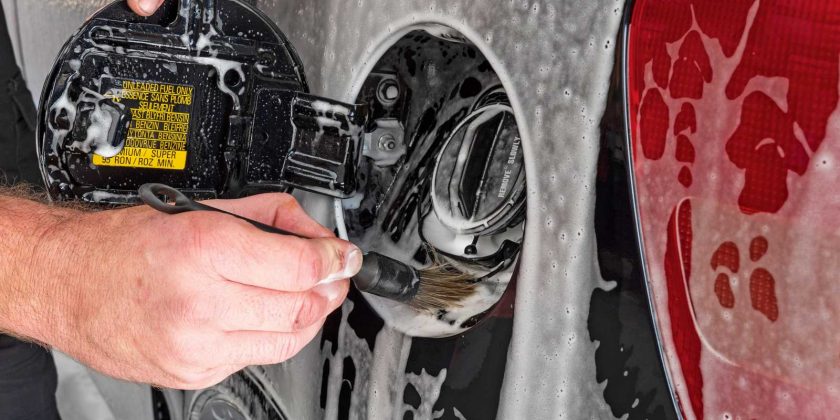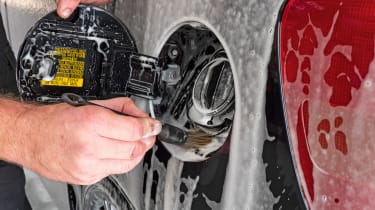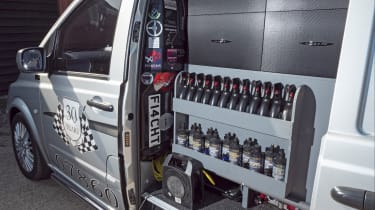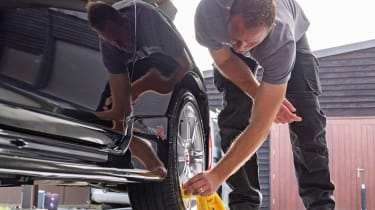Give your car the ultimate clean with our car detailing tips from the leading expert in the field
Car detailing is a term that you’ve probably been hearing more regularly in recent years. It has its origins in the US but now it’s very much over here and in common use. You can wash a car, even valet it, but when we talk about detailing a car we mean taking it to the next level of cleanliness and condition.
A professional car detailing service will leave no stone unturned, trim piece unbuffed or brake caliper unpolished in removing dirt and grime from your car. You can learn to detail a car yourself, of course, and we’ve spoken to the best in the business for some top tips on car detailing technique, kit and tricks of the trade.
How to wash your car
How to detail a car
How do you wash a car like a pro? Do you want to take your soaping skills to the next level? Now, you can go to a car-cleaning class to learn from a man who is considered one of the world’s most experienced valeters. Richard Tipper started his company, Perfection Detailing, 30 years ago, and in that time he has cleaned, valeted and detailed more than 27,000 cars, including priceless museum exhibits and the world’s most valuable supercars.
Following pressure from his clients and 16,500 Twitter followers, Richard started offering masterclasses in car cleaning. For £150, anyone can spend the day with him and a few other like-minded car fans who want to learn from the guru at his base in Chalfont St Giles, Buckinghamshire. We joined him for one of his very first classes to see if we could polish up our skills.
Car care tips: how to protect your investment
The other students all had different reasons for signing up, and have arrived in cars ranging from a 1994 Nissan Micra to a Porsche 911 Turbo. Some are existing clients who want to know how to look after their cars in between their annual Tipper treatments, one is hoping to become a valeter and wanted to learn from the ‘master’.
Others are just enthusiasts who enjoy car cleaning. David Willis, for example, has come down from Edinburgh: “I wanted to know all the tricks and tips, and to meet people like me who don’t think it’s mad to be obsessed with cleaning cars.”
The first surprise is that caring for your car will actually do it harm. “Cleaning does damage them,” Richard says. “You are moving dirt around and it causes tiny scratches to the paint. You need to make sure you minimise them by getting rid of as much grime as possible before you touch it.”
Tipper uses cars belonging to his ‘pupils’ to demonstrate his methods. He selects Richard Scott’s cherished Volvo 480, and the second surprise is that he starts by cleaning the wheels. These tend to be dirtiest part of the car, so most people leave them until last. But Richard says, “If you’re using special cleaner on the wheels, it tends to be applied with a sprayer and you don’t want it blowing over the parts of the car you’ve just cleaned. I do them first so you are rinsing off the overspray when you clean the rest of the car.”
Car detailing kit
His van is full of lotions and potions, including a wheel cleaner that turns brake dust red and makes it look as though the wheel is bleeding. Next he scrubs it with a series of ‘wheel woolie’ brushes which get in between the spokes. Often Richard will get out a jack and actually remove the wheels to clean the insides properly.
Then he makes sure all of the trim and badges are secure before spraying the bottom of the car with a solution called Multi-Purpose Cleaner. “You need to read the instructions to make sure you dilute it correctly, because it can be caustic stuff and it’ll mark aluminium parts if you don’t get it right. You don’t need to go higher than halfway up the doors with this stuff.” To avoid streaks, he always sprays from the bottom of the car upwards.
The car is then rinsed all over. Richard has an industrial-sized jet wash but he uses its lowest setting to replicate the equipment his students are likely to have at home.
Making sure his lambswool wash mitts are clean, he then fills a bucket with water and shampoo. “There is a lot of choice of shampoo, and the buzz words are ‘pH Neutral’. You just want something that it isn’t going to strip off any waxes you have on the car already. Washing up liquid is designed to get rid of greases, so will strip any coating off.”
Richard then cleans the Volvo with a mitt on each hand to speed the process up. Each panel is wiped in straight lines to avoid causing swirls in the paint. The car is then thoroughly rinsed to make sure all of the soap is gone. When it comes to getting the car dry, there are two methods that Richard recommends. “Every time you touch the car you are potentially causing damage. If you are using filtered water, you can just rinse the car and leave it to dry. If you have limescale in your water, you’re going to need to dry it or the water will leave marks.”
Tipper hasn’t used a traditional chamois leather for 20 years, and relies on microfibre drying cloths. Again, he uses one in each hand to avoid leaving prints on the clean paint.
Next he turns to a Honda Civic Type R belonging to David Willis. For this, he uses snow foam, saying: “I thought it was a bit of a fad at first, but now I use it all the time. It takes more of the dirt away before you touch it with a wash mitt. You have to remember that it’s not going to clean the car for you though; you’ll still need to get your hands wet!”
Best car cleaning tips: the secrets to a perfect finish
The Honda is washed, rinsed and dried, before Richard shows us how to use various polishes and waxes. Some, specified by his wealthier clients, cost thousands per jar.
Both cars are left looking spotless, and the students are impressed. The course has taken all day, yet we haven’t touched on cleaning the interiors or ‘paint correction’, where swirls and scratches are polished out; those will be covered in other sessions that Richard will run if there’s demand.
The course hasn’t been advertised anywhere but Richard already has a waiting list, with word spreading through social media. We think his school is going to clean up.
Top 10 car detailing tips
- Bottoms up Start with the wheels first; you don’t want the strong cleaner used to linger on other parts of the car.
- Read the instructions Leaving the products for too long, using too much, or applying to warm paint could do more harm than good.
- Go two-handed Always use a pair of sponges or wash mitts, so your other hand isn’t leaving marks and can do some of the work.
- Clean the cleaner Make sure your sponges or mitts are clean, and check them during the wash; any dirt on them will damage the paint.
- Keep straight Use your wash mitts (or sponges) in straight lines where possible; that way, it will avoid creating swirl marks.
- Wetter is better Don’t let the car dry until you’ve rinsed any foam away. Wash warm parts of the car (such as the bonnet) last.
- Don’t skimp on the rinse Keep the clean water running or you may leave chemical residues on the car.
- Dry with water If you have filtered water there’s no need to actually dry a car. Just let the water pour off the paint.
- Splats all Avoid driving away until any tyre dressing has dried, or it will get flung off the wheels onto your freshly cleaned car.
- Glass act Tipper’s favourite glass cleaner is… water. “Use a damp microfibre cloth, then polish with a dry one. I’ve never found anything better.”
Get all our latest car cleaning kit reviews here…
Source: Read Full Article


 How to wash your car
How to wash your car Car care tips: how to protect your investment
Car care tips: how to protect your investment

 Best car cleaning tips: the secrets to a perfect finish
Best car cleaning tips: the secrets to a perfect finish